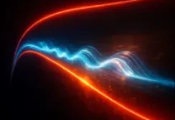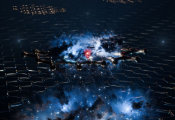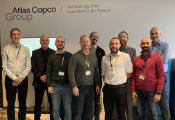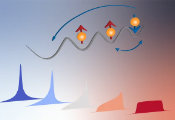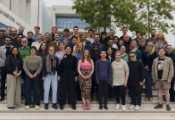Quantum Donuts and Flying Necklaces: Purdue Physicists Capture Elusive Vortex States
August 25, 2025 -- A swirling vortex might look familiar in a glass of water, a hurricane or even a tornado. But when vortices appear in the quantum world, they reveal something far stranger. Purdue University physicists have now observed a long-theorized but never-before-seen quantum state of matter, known as a vortex soliton.
The discovery answers fundamental questions about how quantum matter behaves when pushed into unstable territory. It also provides new building blocks for exploring exotic states of matter that may play a role in future quantum technologies. This breakthrough, led by Chen-Lung Hung, professor of physics and astronomy at Purdue University, has been published in Physical Review Letters.
The experiments were carried out in Hung's quantum gas laboratory by Sambit Banerjee, a graduate student in physics and astronomy. He was joined by Kai Zhou, a visiting scholar, and Rongjie Li, a graduate student, who both played roles in preparing and calibrating some aspects of the experiments.
Banerjee and Zhou worked together to analyze the data. On the theoretical side, Shiva Kant Tiwari, a postdoctoral researcher in chemistry at Purdue, ran supporting simulations under the guidance of Valentin Walther, assistant professor of physics, astronomy and chemistry at Purdue. Collaborators also included Hikaru Tamura from Japan, former postdoctoral scholar of the group, as well as Panayotis Kevrekidis and Simeon Mistakidis, both based at U.S. institutions.
"Vortices are ubiquitous nonlinear excitations appearing in diverse physical systems ranging from classical fluids such as a glass of water, plasma or the atmosphere to complex quantum materials featuring novel quantum properties such as superconductivity," says Banerjee. "In quantum many-body systems with repulsive constituents, a vortex is a stable excitation that manifests as a density defect, extremely robust to external perturbations. In sharp contrast, when a vortex is immersed in media with attractive interactions, where even small density modulations can grow exponentially in time into localized structures at a preferential length scale, it is anticipated to become unstable and eventually collapse."
For years, scientists have puzzled over what really happens when a quantum vortex collapses. How do the dynamics unfold? Can the strange, many-body structures predicted by theory actually form in real time? How long does that process take, and are there general rules that govern a vortex's fate? Until now, the answers were unclear. By combining direct experimental observations with advanced simulations, the Purdue-led team has resolved these long-standing questions.
To find out, the Purdue team turned to their ultracold atom platform. They cooled cesium atoms to a few billionths of a degree above absolute zero, creating a superfluid Bose-Einstein condensate where quantum effects emerge on a macroscopic scale. Using tightly focused laser beams like microscopic chopsticks, they stirred the condensate into a spinning vortex. Then, with a magnetic field, they dialed the atoms' interactions from repulsive to attractive.
That's where the surprise appeared. Instead of collapsing instantly, the swirling superfluid transforms into a self-trapped, donut-shaped droplet, the long-predicted vortex soliton. At stronger attractions, the vortex shattered into a necklace of smaller droplets known as Townes solitons, arranged in a striking circular pattern.
Hung used an everyday image to describe the phenomenon: "This process is like a spinning Ferris wheel turned into a flying necklace of gondolas. Quantum physics makes a cold gas of 40,000 atoms self-pattern into such fascinating structures."
Theoretical work had predicted the existence of vortex solitons for more than two decades, but their instability made them extremely difficult to observe. The Purdue team's ability to create, stabilize and study them experimentally marks a first in the field.
"Observing this is exciting because this elusive state has been theoretically predicted to exist in a superfluid for more than two decades, but has never been realized experimentally, due to the rather specific conditions required for its formation and due to its inherent instability against density modulations in the system," says Banerjee. "We not only observe a vortex soliton-like structure, but we also provide unprecedented insights into the mechanisms leading to its formation, the timescales associated with it, and its eventual fragmentation due to its susceptibility to instabilities in the system."
Solitons, which are self-stabilizing waves that maintain their shape, play a key role across physics and engineering. They appear in optics as stable laser pulses, in plasmas as nonlinear waves, and in condensed matter as particle-like excitations. The discovery of vortex solitons adds an important new member to this family.
"This study reveals the richness of previously unexplored collapse dynamics of a quantum vortex and opens new doorways for both theoretically and experimentally investigating unstable quantum matter with attractive interactions displaying universal properties that are of broad interest to atomic physics, condensed matter and nonlinear optics communities," says Banerjee.
The results may also provide insights into systems that form the backbone of quantum technology. Quantum vortices appear in superconductors, superfluids and even models of the early universe. Understanding their stability and decay could inform efforts to engineer quantum materials with new properties.
"This is happening [at Purdue] because of the unique experimental expertise and apparatus developed by the group over the past years, highlighting Purdue Physics and Astronomy's significant involvement in cutting-edge research for Atomic, Molecular, and Optical physics," says Hung. The work also highlights Purdue's Quantum Science and Engineering Institute, which brings together physicists, chemists and engineers to advance fundamental discoveries and new technologies.
The team is already preparing new experiments to probe the dynamics of vortex solitons in greater detail, including how they interact with other vortices and how they evolve under different conditions.
The project is the result of the NSF CAREER award Grant # PHY-1848316, with continuing support from the PHY-2409591. The experimental apparatus benefited from the support of a W.M. Keck Foundation research grant. The team further acknowledge the support from the AFOSR (FA9550-22-1-0327), the DOE QuantISED program through the Fermilab Quantum Consortium, and the Purdue Physics Rolf Scharenberg Graduate Summer Research Fellowship.


